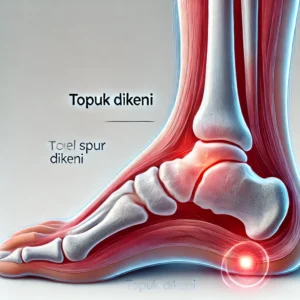Heel spur is a bony growth that develops on the heel bone (calcaneus), often causing intense pain in the heel area, especially when standing or walking after periods of rest. Many people confuse heel spurs with plantar fasciitis because both conditions share similar symptoms, but they are not exactly the same. A heel spur forms when calcium deposits accumulate on the heel bone over time, creating a sharp, spike-like structure. While some people may have heel spurs without any symptoms, others experience chronic heel spur pain that affects their daily activities. Understanding what a heel spur is and how it develops is the first step toward finding effective heel spur treatment options.

What Is a Heel Spur?
A heel spur is a pointed bony outgrowth that typically forms at the bottom of the heel bone, near where the plantar fascia connects. It often develops as a response to long-term strain on the foot muscles and ligaments. Over time, this stress can lead to tiny tears in the heel area, causing the body to deposit calcium to protect the bone. This process eventually results in a hard, protruding growth known as a heel spur.
Although heel spurs themselves may not always cause pain, they are commonly associated with heel spur syndrome, a condition where the spur irritates surrounding soft tissues, leading to inflammation and discomfort. People with heel spur symptoms often report stabbing pain in the morning or after sitting for long periods, which improves after walking for a while. The size of a heel spur can vary, but most range between 2 mm and 12 mm. While small heel spurs may go unnoticed, larger ones often require heel spur treatment to relieve discomfort and prevent further complications.
How Do You Get a Heel Spur?
A heel spur develops gradually due to repetitive stress and strain on the heel bone and surrounding soft tissues. The most common cause is prolonged tension in the plantar fascia, the thick ligament that connects the heel bone to the toes. When this ligament becomes overstretched or inflamed, small tears occur in the tissue, prompting the body to deposit calcium at the injury site as a protective measure. Over time, this calcium build-up hardens and forms a sharp, bony protrusion known as a heel spur.
Several factors increase the risk of developing a heel spur. These include excessive physical activity, especially high-impact sports like running or jumping, which put pressure on the heels. Poor footwear, such as shoes with inadequate arch support, can also contribute to the formation of heel spur pain. Additionally, obesity and long hours of standing increase stress on the feet, accelerating spur development. People with flat feet or high arches are also more likely to experience heel spur symptoms due to improper weight distribution. Understanding these causes is essential for prevention and effective heel spur treatment.
What Are the Symptoms of a Heel Spur?
The most common heel spur symptoms include sharp, stabbing pain in the heel, especially when taking the first steps in the morning or after sitting for an extended period. This pain is usually localized at the bottom of the heel and can radiate toward the arch of the foot. While the pain often decreases after walking for a few minutes, it may return after long periods of standing, running, or engaging in high-impact activities. The discomfort is caused by inflammation of the soft tissues surrounding the heel spur, rather than the bony growth itself.
Other signs of heel spur syndrome include swelling, tenderness, and warmth in the affected area. Some people may experience a visible bump or feel a hard protrusion when pressing on the heel, though this is rare. Unlike plantar fasciitis, which causes pain primarily in the morning, heel spur pain can persist throughout the day and worsen with physical activity. If these symptoms continue for weeks without relief, it is essential to consult a specialist for proper heel spur treatment, which may include exercises, medications, or even heel spur removal in severe cases.
Types of Heel Spur
Heel spurs are generally categorized based on their location on the heel bone. The two primary types are plantar heel spur and posterior heel spur, each with different characteristics, symptoms, and treatment approaches. Understanding these types can help in identifying the condition accurately and determining the most effective heel spur treatment.
Plantar Heel Spur
A plantar heel spur forms at the bottom of the heel bone, where the plantar fascia attaches. This type is the most common and is often associated with heel spur pain during the first steps in the morning or after long periods of rest. Plantar heel spurs develop when excessive stress is placed on the plantar fascia, causing inflammation and microtears that lead to calcium deposits.
Patients with plantar heel spurs may experience severe discomfort when walking barefoot on hard surfaces or engaging in activities that put extra pressure on the heel. Conservative heel spur treatment methods like custom orthotics, physical therapy, and heel spur exercises can significantly reduce pain and improve mobility. In chronic cases where these measures fail, heel spur surgery might be considered.
Posterior Heel Spur
A posterior heel spur develops at the back of the heel bone, near the insertion of the Achilles tendon. Unlike plantar spurs, these often result from repetitive strain on the Achilles tendon, which can occur in athletes or people who wear tight footwear for extended periods. Symptoms include swelling, tenderness, and pain at the back of the heel, especially when running or climbing stairs.
Treatment for posterior heel spurs typically involves rest, anti-inflammatory medications, and stretching exercises to relieve tension in the Achilles tendon. In severe cases where conservative treatments fail, heel spur removal or surgical correction may be necessary. Proper footwear with cushioning and supportive heel counters is crucial for long-term heel spur pain relief.
How Is a Heel Spur Diagnosed?
Diagnosing a heel spur involves a combination of clinical evaluation and imaging tests. During a physical examination, the doctor will check for tenderness, swelling, and pain in the heel area, often focusing on where the plantar fascia attaches to the heel bone. The symptoms alone, however, are not always enough to confirm the presence of a heel spur because similar pain can occur with other conditions like plantar fasciitis.
To make an accurate diagnosis, imaging techniques such as heel spur X-ray are essential. X-rays can reveal the size, shape, and exact location of the bony growth. In some cases, an ultrasound or MRI may also be used to assess soft tissue involvement and rule out other causes of heel spur pain. A proper diagnosis ensures that patients receive the most effective heel spur treatment, whether through conservative measures like physical therapy and orthotics or advanced options like heel spur surgery in severe cases.
What Kind of Doctor Treats a Heel Spur?
When dealing with persistent heel spur symptoms, it’s important to consult the right specialist. Typically, an orthopedic doctor or a podiatrist (foot specialist) handles heel spur treatment. These experts are trained to diagnose and manage conditions affecting the bones, ligaments, and muscles of the foot. In some cases, a physical therapist may also be involved to recommend heel spur exercises and rehabilitation strategies for pain relief.
If conservative treatments fail and heel spur removal or heel spur surgery becomes necessary, an orthopedic surgeon will usually perform the procedure. Choosing a qualified doctor is crucial to ensure accurate diagnosis, proper management, and long-term heel spur pain relief.
What Is the Treatment for a Heel Spur?
Effective heel spur treatment usually begins with conservative methods aimed at reducing pain and inflammation rather than immediately opting for surgery. The first step often involves rest, applying ice packs, and using anti-inflammatory medications to alleviate discomfort. Doctors may also recommend orthotic inserts or custom shoe supports to redistribute pressure and provide cushioning for the heel. These simple changes can significantly improve symptoms and prevent further stress on the heel bone.
Physical therapy is another important component of non-surgical heel spur pain relief. Therapists often prescribe heel spur stretches and strengthening exercises to improve flexibility and reduce strain on the plantar fascia and Achilles tendon. Night splints, which keep the foot stretched during sleep, can also help relieve early-morning pain. If these measures do not provide sufficient relief, corticosteroid injections may be used to reduce inflammation in the affected area.
For severe cases that do not respond to conservative treatments, heel spur surgery or heel spur removal may be considered. Surgical options include removing the bony growth or releasing the plantar fascia to reduce tension. While surgery can be highly effective, it is generally recommended as a last resort due to potential risks and a longer recovery period. Most patients find significant improvement with non-invasive approaches, making early intervention and consistent care the best strategy for long-term relief.
Heel Spur Treatment in Turkey
Turkey has become one of the leading destinations for heel spur treatment thanks to its combination of advanced medical technology, experienced orthopedic specialists, and affordable healthcare services. Many patients from Europe, the Middle East, and other regions travel to Turkey for treatment due to the high standards of care and significantly lower costs compared to other countries. Hospitals and clinics in Turkey are equipped with state-of-the-art diagnostic tools, including heel spur X-ray imaging and advanced physiotherapy equipment, ensuring accurate diagnosis and effective treatment plans.
Another advantage of choosing heel spur treatment in Turkey is the availability of comprehensive medical tourism packages. These packages often include consultations, treatment, accommodation, and transportation, making it a convenient option for international patients. Turkish doctors are highly experienced in both conservative methods and surgical procedures such as heel spur surgery and heel spur removal. Additionally, post-treatment rehabilitation and guidance on heel spur exercises are provided to ensure complete recovery. With affordable pricing and world-class healthcare services, Turkey offers an excellent solution for patients seeking long-lasting heel spur pain relief.
How To Fix a Heel Spur?
Fixing a heel spur depends on the severity of the condition and the patient’s response to conservative treatments. In most cases, non-surgical methods are highly effective in providing heel spur pain relief and preventing the need for invasive procedures. One of the simplest steps is to wear properly cushioned shoes with good arch support to reduce pressure on the heel bone. Orthotic insoles are also recommended to help with foot alignment and distribute body weight evenly, minimizing strain on the plantar fascia.
For additional relief, patients can try home remedies such as applying ice packs to reduce inflammation or taking over-the-counter anti-inflammatory medications. Performing heel spur stretches and heel spur exercises daily is essential for improving flexibility and strengthening the foot muscles. If conservative measures fail to provide relief after several months, more advanced options like corticosteroid injections or heel spur surgery may be necessary. Surgery is generally reserved for severe cases where chronic pain interferes with mobility and quality of life. Following a proper treatment plan under medical supervision ensures effective recovery and long-term results.
Things To Consider for Those With a Heel Spur
Living with a heel spur requires adopting certain habits to manage pain and prevent the condition from worsening. The first and most important consideration is proper footwear. Shoes should have adequate cushioning, strong arch support, and a slightly raised heel to reduce stress on the plantar fascia and heel bone. Walking barefoot on hard surfaces should be avoided, as this can increase strain and lead to more severe heel spur pain. Using silicone heel pads or orthotic inserts can significantly improve comfort and reduce pressure on the affected area.
Another key factor is weight management. Excess body weight places additional stress on the feet, which can accelerate the development of heel spur symptoms and make treatment more challenging. Incorporating low-impact exercises such as swimming or cycling can help maintain fitness without putting extra pressure on the heels. Regular stretching of the calf muscles and plantar fascia is also essential for heel spur pain relief. Patients should avoid sudden increases in physical activity and always warm up before exercising. Following these guidelines can help reduce discomfort and prevent the need for invasive treatments like heel spur surgery.
Exercises for Heel Spur
Regular stretching and strengthening exercises play an essential role in heel spur treatment. They help relieve tension in the plantar fascia, improve flexibility, and provide long-term heel spur pain relief. One of the most effective stretches is the calf stretch: stand facing a wall, place your hands on the wall, and keep one leg straight behind you with the heel on the ground. Hold this position for 20–30 seconds and repeat several times on each leg. This exercise reduces strain on the Achilles tendon and heel bone.
Another highly recommended exercise is the plantar fascia stretch. Sit on a chair and cross one foot over the opposite knee. Gently pull your toes back toward your shin to stretch the bottom of your foot. Hold the stretch for 15–20 seconds and repeat 3–4 times per foot. Additional exercises such as rolling your foot over a cold water bottle or tennis ball can help massage the fascia and decrease inflammation. Incorporating these heel spur stretches and exercises into your daily routine can significantly speed up recovery and reduce the need for invasive options like heel spur surgery.
Frequently Asked Questions About Heel Spur
How do I know if it’s a heel spur?
You may suspect a heel spur if you experience sharp pain in your heel, especially during the first steps in the morning or after sitting for long periods. A definitive diagnosis requires an X-ray, which can reveal the bony growth. Consulting a specialist is the best way to confirm heel spur symptoms and start the right treatment.
What happens if a heel spur is left untreated?
If left untreated, a heel spur can lead to chronic pain and reduced mobility. Over time, inflammation and irritation may worsen, making even basic activities like walking or standing painful. Untreated heel spur pain can also cause compensatory changes in gait, potentially leading to knee, hip, or back issues.
What is the difference between a heel spur and plantar fasciitis?
While both conditions cause heel pain, they are not the same. A heel spur is a bony growth on the heel bone, whereas plantar fasciitis is inflammation of the ligament that connects the heel to the toes. Many people have both conditions simultaneously, and the treatment often overlaps, including heel spur stretches and orthotics.
Will a heel spur get better on its own?
A heel spur will not disappear on its own because it is a bony formation. However, the associated pain and inflammation can improve with proper heel spur treatment, including rest, physical therapy, and lifestyle changes. Surgery for heel spur removal is usually only necessary in severe cases.
Is it good to rub a heel spur?
Rubbing or massaging the area around a heel spur can provide temporary heel spur pain relief, especially if done gently and combined with stretching exercises. However, aggressive massage can worsen inflammation, so it’s best to follow a doctor-recommended approach for heel spur treatment.



